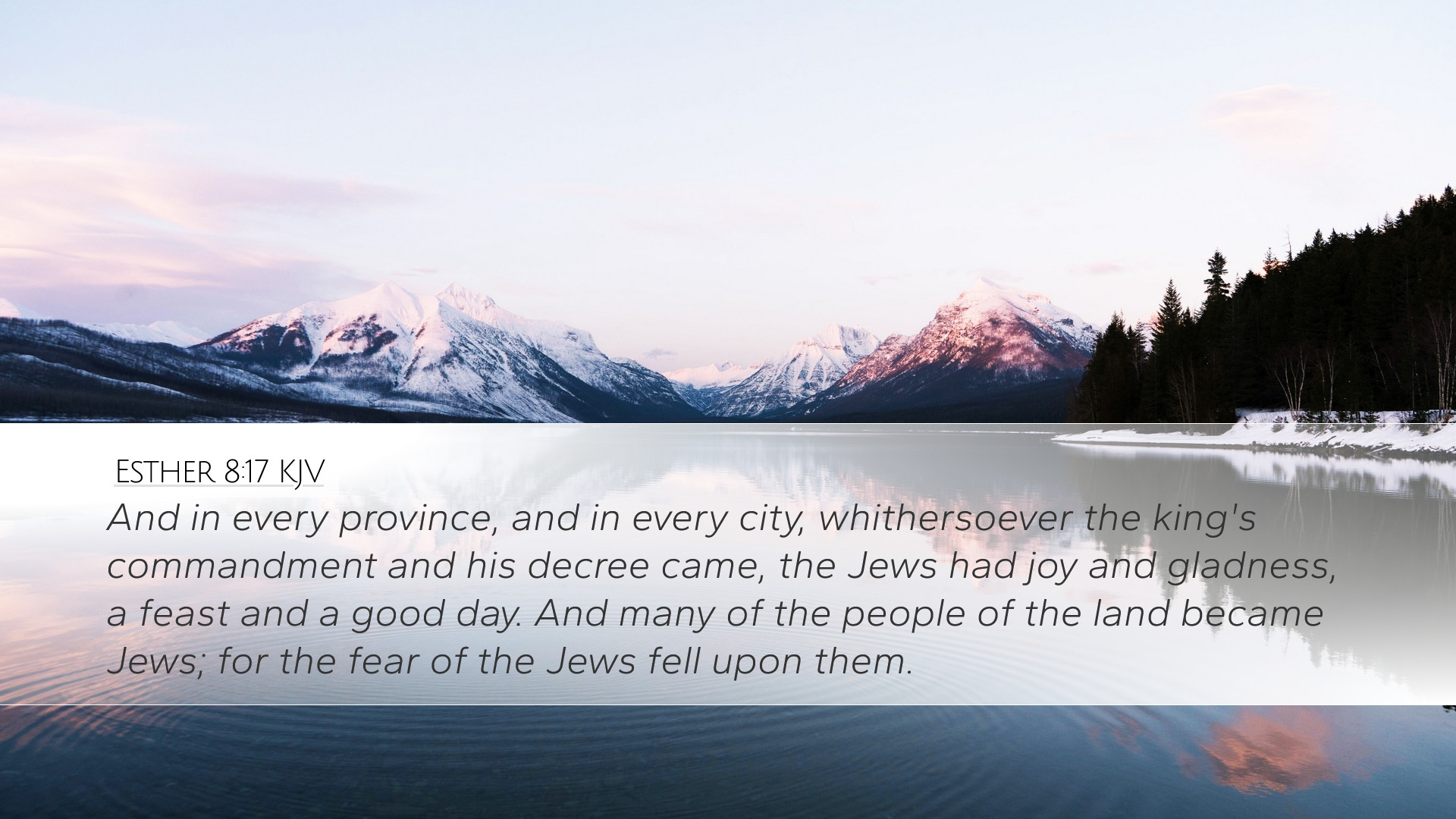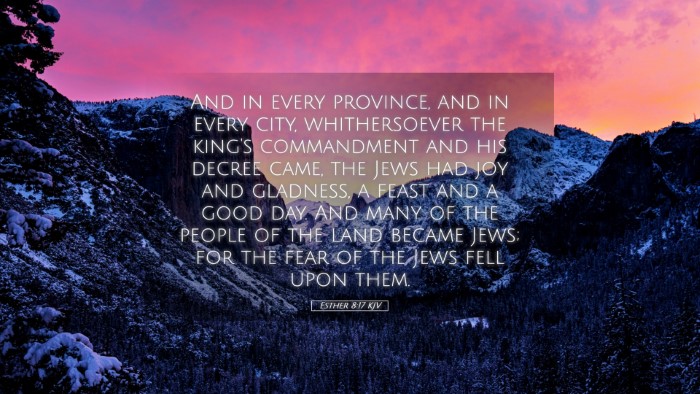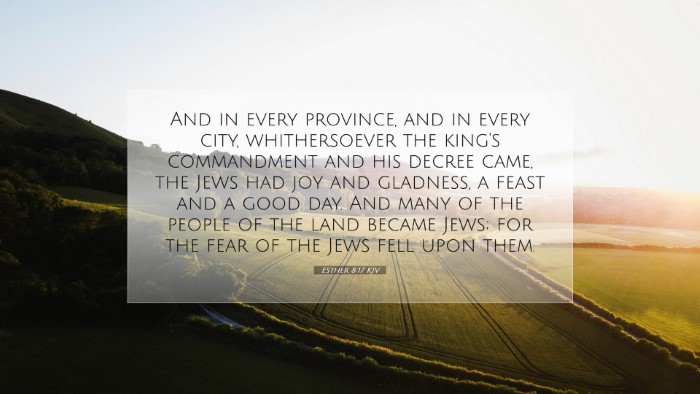Old Testament
Genesis Exodus Leviticus Numbers Deuteronomy Joshua Judges Ruth 1 Samuel 2 Samuel 1 Kings 2 Kings 1 Chronicles 2 Chronicles Ezra Nehemiah Esther Job Psalms Proverbs Ecclesiastes Song of Solomon Isaiah Jeremiah Lamentations Ezekiel Daniel Hosea Joel Amos Obadiah Jonah Micah Nahum Habakkuk Zephaniah Haggai Zechariah MalachiEsther 8:17
Esther 8:17 KJV
And in every province, and in every city, whithersoever the king's commandment and his decree came, the Jews had joy and gladness, a feast and a good day. And many of the people of the land became Jews; for the fear of the Jews fell upon them.
Esther 8:17 Bible Commentary
Exegesis of Esther 8:17
Bible Verse: Esther 8:17 - "And in every province and in every city, whithersoever the king's commandment and his decree came, the Jews had joy and gladness, a feast and a good day. And many of the people of the land became Jews; for the fear of the Jews fell upon them."
Contextual Overview
The Book of Esther narrates the story of a Jewish woman who became queen of Persia and played a pivotal role in saving her people from annihilation. The verse in question comes shortly after Queen Esther's plea to King Ahasuerus and the issuance of a new decree allowing the Jews to defend themselves against their attackers. This decree established a profound turning point in the narrative, marking a reversal of fortunes for the Jewish people.
Thematic Insights from Public Domain Commentaries
The Rejoicing of the Jews
Matthew Henry emphasizes the significance of joy as a response to deliverance. In his commentary, he notes that the gladness expressed by the Jews symbolizes not only physical safety but also spiritual liberation. The joy described in Esther 8:17 is reflective of a deeper covenant relationship with God, as the Jews recognize His hand in their preservation.
Albert Barnes adds that the decree initiated a festival atmosphere among the Jews, as they transitioned from a time of mourning (in response to Haman's plot) to a time of celebration. This celebration encompasses not only their safety but also a newfound identity and pride in their heritage. This festive spirit is crucial for the Jewish community as they reaffirm their cultural and spiritual identity amid a foreign land.
The Impact on the Gentiles
Henry notes an intriguing phenomenon where “many of the people of the land became Jews.” This incursion into the Jewish faith by others highlights a shift in perception towards the Jewish people. Initially seen as a marginalized group facing potential destruction, they now command respect and fear among their neighbors. This transformation is significant, suggesting that the faith and conduct of the Jews under duress were powerful testimonials that influenced others to align themselves with the God of Israel.
Adam Clarke elaborates on this transformation, indicating that the fear the Gentiles experienced acted as a catalyst for conversion. The fear of the Jews, ignited by the miraculous turn of events and divine protection, prompted these people to adopt Jewish customs, evidencing the profound impact of God's favor on his people.
Literary and Theological Reflections
The structure of Esther 8:17 exemplifies a juxtaposition of turmoil and triumph. As lament gives way to joy, it mirrors the overarching biblical narrative of redemption. Theological implications arise profoundly, as this passage encapsulates themes of divine sovereignty, covenant fidelity, and the nature of communal identity.
Covenant Theology
The transition from sorrow to joy can also be viewed through the lens of covenant theology. The Jews' preservation and subsequent celebration highlight God’s steadfast love and faithfulness to His covenant people. As noted by Henry and Barnes, the acknowledgment of God's hand in their deliverance adds a dimension of spiritual renewal and commitment that resonates deeply in a theological context.
Identity and Community
This verse invites reflection on issues of identity, particularly in a multicultural context. The Jews, as a distinct group within the Persian Empire, find themselves reaffirming their place and purpose. The response of the Gentiles not only signifies a recognition of Jewish distinctiveness but also suggests a longing for belonging amidst cultural plurality. The mutual recognition of identity invites pastoral reflection on how churches today can navigate plurality while maintaining distinctiveness in the gospel.
Practical Applications for Today’s Church
Esther 8:17 serves as a rich source for application within the contemporary church. It prompts believers to rejoice in God's deliverance and challenge congregations to foster an environment of celebration in recognition of God’s works. Furthermore, it raises the question of how Christians can be a compelling witness in a pluralistic society, much like the Jews whose conduct inspired the conversion of many in their time.
- Celebration of Deliverance: Churches should incorporate times of rejoicing in their worship services to reflect on God’s goodness and faithfulness.
- Intercessory Prayer: Reflecting the Jewish community's reliance on prayer through Esther's intercession, congregational prayer should be emphasized as a means of seeking divine intervention.
- Emphasizing Identity: Discipleship programs can focus on helping believers understand their identity in Christ and how this impacts their roles in their communities.
- Cultural Engagement: The transformation of outsiders becoming ‘Jews’ encourages believers to engage culture with the hope of drawing others to the faith.
Conclusion
In the climactic moment captured in Esther 8:17, we witness a marvelous interplay of joy, fear, and identity that enriches our understanding of God's engagement with His people. The interpretations offered by esteemed commentators like Matthew Henry, Albert Barnes, and Adam Clarke allow us to appreciate the profound layers of meaning in this verse. As pastors, students, theologians, and scholars, there is an invitation here to delve deeper into how God’s deliverance influences not just individuals, but entire communities, reverberating through time as a testament to His unyielding love and faithfulness.


